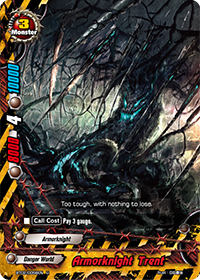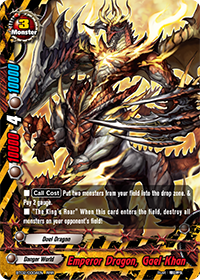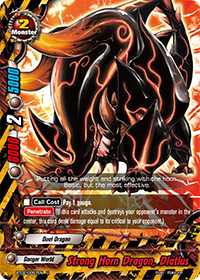Reason A: A single Size 3 monster must do what 1 Size 2 and 1 Size 1 or 3 Size 1's can do.
Reason B: A single Size 3 monster must be able to absorb the same number of attacks that 1 Size 2 and 1 Size 1 or 3 Size 1's can take.
Reason A
People love Size 1's because "Wow! You can flood the field with 3 of them and get 3 attacks off! Huge advantage!" This is certainly true. I even proved in the Field Control article that attacks generate advantage. Also, since calling to the field is a wash, you're not really losing anything when you're calling them. 3 attacks are certainly better than one. So all's good, right? |
| I am the red wave that will cover the lands |
Of course, when you factor in crits, it's an undeniable fact that Size 1 swarming will on average do much more damage. With the average crit of a Size 1 at 1.5 and the average crit of a Size 3 at 2.5, it's no surprise that the aggro deck relies on the swarm. And even in this situation, a Double Attack 3-crit monster will do just as much damage as a full field of 2-crit Size 1's.
But let's just say that you're not too worried about damage, focusing instead on field clearing. This is the normal approach to a game, after all, since you shouldn't focus on damage until you can push for game. At this point, a Size 3 is only a -1 if you can deal a 8000 power attack. If your Size 3 has Double Attack, then it actually gains in field clearing potential while only being about -1 in terms of damage. Of course, this all depends on your Size 3 that you choose, but I'm pretty sure that you're not using something like Gigant Sword Dragon.
Reason B
Well, if Size 3's offensively can hold their own through Double Attack and hitting magic numbers, then they must be lacking in the defensive department, right? After all, if you call 3 extremely pressuring Size 1's you can drain 3 attacks from your opponent! |
| You shall not pass |
Another important thing to note is that Size 3's are usually safe from many general-purpose removal spells. Even multiple-clear and field-clearing spells are usually wasted and overcosted when removing only a single monster. Size 3 is safe from spells like Begone!!, Magical Goodbye, while being relatively untouched by power/defense threshold removal spells like Dragonbreath. Spells that can remove Size 3 monsters are often overcosted (-2 for +1).
Finally, while three Size 1's might be threatening and may compel your opponent to waste 3 attacks to clear the field, remember that only 1 of those Size 1's is guarding your life. If your opponent sees an opening and decides to gun you down for damage, no amount of Size 1 field presence can save you from that. Whereas a huge Size 3 in the middle is often enough to clip the damage of an one-turn-kill. This becomes more and more important the later you go into a game. When both players are reduced to hand sizes of 0 and are basically drawing their next play, Size 3 monsters really show off just how much more quality they are.
Quality over Quantity
This is the entire reason why Size 3-based decks like Ancient World decks can exist in the first place. Quality and quantity, carefully balanced through the entire card game, have certain advantages and disadvantages compared to each other. Quantity draws its power from raw calculations - it allows a player to directly multiply the effectiveness of a single turn. Quality, on the other hand, is dependent on the situation, and can either maximize the potential of a turn or waste it all. Since the effectiveness of cards based on quality can fluctuate so much, it's important to pinpoint or calculate the expected value gains from the card in the context of different situations in order to determine the card's worth. To do so, we'll be using a more qualitative version of mathematics, similar to magnitude notation used to solve fermi estimates.
Let's do a fermi-style total estimate for Emperor Dragon, Gael Khan. This is a good example card, since people are often confused whether Gael Khan is actually good or not. First we start with basic advantage principles. Gael Khan costs -2 from field and -2 gauge. That means that on-call, he's looking at about -3 total advantage to even get on the field. Ouch. Well, it's not that bad, since his stats are way up there. 10000 for both power and defense? Pretty good. Power above 9000 is somewhat frivolous, but the 10000 defense is in the range where not every link attack is going to hit that thing. Since it's hard to calculate how much 10000 defense is worth over, say, 8000 defense, we'll qualify it instead. 10000 defense can be hit by link attacks of 5000/5000, 6000/4000, 7000/3000, 8000/2000, 9000/1000. The first two can be reached by Size 1's only, but the odds of either happening are not comfortably high. Certainly, most decks will run 4 of a 5000 power beater, but not many decks double up on those. That is to say, to clear Gael Khan with only Size 1's is going to be a tall task (unless you're running 4 Blade Chakram and 4 Thousand Rapier). Most likely, you'll be clearing Gael Khan with either a Size 1 and a Size 2 or some other combination of a link attack overreach.
If Gael Khan is taken down by 2 Size 1's (worst case scenario), he's drained a -1 from the opponent (link attack), making his defensive stat worth a net +1. But we've already qualified that this isn't always going to be the case, and in fact is not going to be a common case. Thus Gael Khan will likely either draw a triple link attack (-2 from the opponent) or a Size 2 drop from the opponent. The Size 2 drop is the wildcard here. It's impossible to ascertain whether forcing your opponent to drop a Size 2 is a good or bad thing without determining the Size 2. If the Size 2 was Bladewing Phoenix, your opponent didn't suffer much, but if the only way he was going to get over your Gael Khan was to call a Thunder Knights, Battle Axe Dragon then you know that you've forced your opponent to overextend. In other words, we have to use our own good judgement to weigh the net advantage in this case. The advantage can be anything between +1 or +2, +1 if the opponent suffered no overreach and +2 if the opponent suffered a lot of overreach. Some more examples would be good, I suppose. Strong Horn Dragon, Diatlus would be +1 no overreach. Drum Bunker Dragon would be +1.5 slight overreach. Jackknife "Aggressor" would be +2 much overreach. By the way, using a weapon in this scenario would also be overreach based on the circumstances (unless it was Hysteric Spear).
When all is said and done, I think 10000 defense draws +1.5 in terms of overreach. This is because there are many staple Size 2's that don't even hit 5000 power (Mary Sue, Quenzwei) and even more staple Size 1's that hover around 2000-3000 power. While I don't think Gael Khan consistently draws triple link attacks, I can't say for sure that it's out of the picture. On the other hand, however, there's some really good removal out there that can rid Gael Khan breezily: Cerberus, Hearty the Devastator, Geppakugiri to name a few. Some opponents can just simply bypass the defense altogether, so there's no guarantee it will be effective. Thus, I feel like +1.5 advantage is appropriate. Hey, how much did we calculate +2000 defense to be worth? +0.5 advantage, right? If 8000 defense will on average draw +1 through either link attack or Size 3 overextend (given), then it fits all too well that 10000 defense, which by advantage calculations would be +0.5 relative, can be qualified to be +0.5 relative as well. When your qualifications match your calculations, you know life is good.
That was a lot just for Gael Khan's stats, but there's still two more aspects of this beefy dragon we have to cover. The first is his 4-crit. How much is 4-crit worth? Well, normally we'd just say +2 and move on. But in this case, we need to qualify his net worth in terms of circumstances. Nobody's going to idly take 4-crit to the face without resistance. If they have a shield or negate, they're going to use it here. Most decks are nearing the 8 negates mark, but for the purpose of fairness we'll assume that there are 6 negates in the deck, meaning a 12% average of having one in hand. 12% of +2 is 0.24, which is so small it's not really even meaningful (it's the difference between 1 direct damage and 1 actual damage/life). In other words, you can essentially discount shields/negates from affecting the expected gain from slamming your opponent with a 4-crit attack. You'll more or less get the +2 you wanted from the attack, and even if you don't you've wasted one of their shields which is basically a +1. .88 * 2 + .12 * 1 might as well be 2.
However, there's another rather glaring issue with Gael Khan. That's the fact that since he's a Size 3, you can't exactly call strong monsters to the field apart from him. So when your opponent starts dropping monsters in the center to block Gael Khan's 4-crit attacks, we have to reconsider his worth. How likely will an opponent have a monster to call to the center against Gael Khan? Very likely. So likely that we're going to assume 100% because no decently intelligent person would refuse to call a monster to the center to guard Gael Khan (I said guard Gael Khan; it's a different matter if you're just going to kill it). When Gael Khan attacks the center to clear it, how much advantage does he get? +1 only. Sure, he more or less guarantees a 4-crit attack the turn he's played and blows up the field, but after that he's basically never going to hit the opponent ever again. In other words, he's at full potential on-call and gets neutered afterwards until he dies (which means you shouldn't ever call him to the side unless it's game). This fits with what I've said before about field control in regards to field blocking (yes, you can field block Gael Khan). This is also why you don't want to run Size 3's without Double Attack or Penetrate.
So far, Gael Khan has a +0.5 defensive edge and a +1 offensive edge to cover for his -3 call cost. His last ability is supposed to make up for it. On-call, he clears the opponent's entire field of all monsters. Perfect field sweep. It's very strong, but field sweeps like that are heavily dependent on quality and timing. You're not going to want to call Gael Khan when your opponent only has 1 monster on the field, unless the monster is a Size 3. Which means that there are times when Gael Khan isn't worth it to call. Time for more qualifications then! Gael Khan's on-call ability The King's Roar can net anywhere from +1 to +3 advantage determined by the field setup. We're not going to go over every example here (it's impossible), so to save time and space we'll just 50% it for an expected gain of +2. That means that The King's Roar is +2 advantage on average. In other words, you can call Gael Khan when there's 2 monsters on the field in order to gain the acceptable advantage from his ability.
If we add up all our qualifications, we see that Gael Khan, through it's various stats and abilities, ends up being about +0.5 in terms of total advantage. That's not half bad, especially when practically it comes out to be a field wipe and 4 damage on your opponent. It does 2/3d's of the damage Demon does while clearing the entire field, meaning that even if your opponent survives he's going to be coming from behind. Against a 10000 defense behemoth. Honestly, the only reason Duel Dragons are playable is because this guy exists. Coupled with Duel Law, this card has the potential to completely shut down an opponent in ways that only a Size 3 monster can do.
Don't forget to wrap it up and connect it back to the beginning. Does Gael Khan do the equivalent of 3 Size 1 monsters? I say easily. It's funny, since Gael Khan literally costs 3 monsters (2 as sacrifice), so it was probably the best choice of an example for comparison in this article that I could possibly arbitrarily choose. To equate Gael Khan's prowess with 3 Size 1's, you would most likely need at least 1 Size 1 with Penetrate in order to compete at the same damage level. Whereas Gael Khan can take any random two monsters (even Size 2's) as sacrifice, meaning that Gael Khan is actually more flexible by itself.
Keep in mind that Gael Khan isn't even the cream of the Size 3 crop. Gael Khan is one of those Size 3's that does it all, and thus ends up costing a lot more (3 cards worth). Armorknight Demon costs -2, and explodes damage in your face. Rebel, Belial, Magic World's best Size 3, comes in at -1.5 and works as a even more versatile Gael Khan at much less cost. Don't forget Extermination Ninja, Slashing Asura, who is free to call and can pay as little as -0.5 for a perfect field clear. And don't even get me started on Ancient World Size 3's.
Advantage qualifications like the one above help clarify the finer details of certain cards that, while they may appear good on paper, end up not performing at the same level as theorycrafted, or vice versa. The process may be long-winded and protracted, but the end result is a greater understanding of the entire context of how a specific card functions in a game.
 |
| Kneel before me |
 |
| Atlus strong |
 |
| No, I have have a really bad memory |
That was a lot just for Gael Khan's stats, but there's still two more aspects of this beefy dragon we have to cover. The first is his 4-crit. How much is 4-crit worth? Well, normally we'd just say +2 and move on. But in this case, we need to qualify his net worth in terms of circumstances. Nobody's going to idly take 4-crit to the face without resistance. If they have a shield or negate, they're going to use it here. Most decks are nearing the 8 negates mark, but for the purpose of fairness we'll assume that there are 6 negates in the deck, meaning a 12% average of having one in hand. 12% of +2 is 0.24, which is so small it's not really even meaningful (it's the difference between 1 direct damage and 1 actual damage/life). In other words, you can essentially discount shields/negates from affecting the expected gain from slamming your opponent with a 4-crit attack. You'll more or less get the +2 you wanted from the attack, and even if you don't you've wasted one of their shields which is basically a +1. .88 * 2 + .12 * 1 might as well be 2.
 |
| Even I can stop the mighty Gael Khan |
So far, Gael Khan has a +0.5 defensive edge and a +1 offensive edge to cover for his -3 call cost. His last ability is supposed to make up for it. On-call, he clears the opponent's entire field of all monsters. Perfect field sweep. It's very strong, but field sweeps like that are heavily dependent on quality and timing. You're not going to want to call Gael Khan when your opponent only has 1 monster on the field, unless the monster is a Size 3. Which means that there are times when Gael Khan isn't worth it to call. Time for more qualifications then! Gael Khan's on-call ability The King's Roar can net anywhere from +1 to +3 advantage determined by the field setup. We're not going to go over every example here (it's impossible), so to save time and space we'll just 50% it for an expected gain of +2. That means that The King's Roar is +2 advantage on average. In other words, you can call Gael Khan when there's 2 monsters on the field in order to gain the acceptable advantage from his ability.
 |
| Dual Law |
Don't forget to wrap it up and connect it back to the beginning. Does Gael Khan do the equivalent of 3 Size 1 monsters? I say easily. It's funny, since Gael Khan literally costs 3 monsters (2 as sacrifice), so it was probably the best choice of an example for comparison in this article that I could possibly arbitrarily choose. To equate Gael Khan's prowess with 3 Size 1's, you would most likely need at least 1 Size 1 with Penetrate in order to compete at the same damage level. Whereas Gael Khan can take any random two monsters (even Size 2's) as sacrifice, meaning that Gael Khan is actually more flexible by itself.
Keep in mind that Gael Khan isn't even the cream of the Size 3 crop. Gael Khan is one of those Size 3's that does it all, and thus ends up costing a lot more (3 cards worth). Armorknight Demon costs -2, and explodes damage in your face. Rebel, Belial, Magic World's best Size 3, comes in at -1.5 and works as a even more versatile Gael Khan at much less cost. Don't forget Extermination Ninja, Slashing Asura, who is free to call and can pay as little as -0.5 for a perfect field clear. And don't even get me started on Ancient World Size 3's.
Advantage qualifications like the one above help clarify the finer details of certain cards that, while they may appear good on paper, end up not performing at the same level as theorycrafted, or vice versa. The process may be long-winded and protracted, but the end result is a greater understanding of the entire context of how a specific card functions in a game.
The 3 Factor
I personally think every single deck should run at least 1-2 Size 3's. Without exception. Yes, even Adventurers. The undeniable truth is that Size 3's can do so much with their quality that running even a few will open up so many different options for the player to take advantage of. Size 3's are also great late-game insurance.
When choosing Size 3's to use, try to choose some that have Penetrate or Double Attack. Very few Size 3's are playable that don't carry one or the other. This simply helps guarantee damage when you need it and also increases the pressure of the card. If the Size 3 doesn't have either ability, it needs some form of field removal. There has to be a way for the Size 3 to guarantee damage and control.
As far as numbers go, anywhere from 2-8 Size 3's are easily playable in any deck. The deck doesn't even have to revolve around Size 3's. Ancient World is the exception, as you'll find many of their decks running 12 or even more Size 3's. If you think about the way ratios work in Vanguard and Weiss Schwarz (as always, moreso Weiss Schwarz than Vanguard), where Grade/Level 3's help increase potency in late game, then you'll notice the similarity with Size 3's in Buddyfight.
All images were used obtained from the official Bushiroad website and used here solely for reference purposes. Future Card Buddyfight!, logos, and respective content belong to Bushiroad.Large images belong to the Buddyfight! Wikia.

Literally the only thing I disagree with in this article is the 1st sentence of the 1st paragraph of "The 3 Factor" section. I think 1 is too low for anything that can't be searched. Though, I do completely agree that every deck should be running Size 3's. I have a decklist built for every deck type, and the only ones that lack Size 3's are Pure Adventurers (I lie, just changed that) and 72 Pillars. Besides that, every single one runs 2-3 of a Size 3.
ReplyDeletewhy does every deck need to run size 3s? By running size 3s you are showing intent to play it but the triple offensive formation does not have room for size 3s. If your game plan is weapon, size 1, size 2 set up then runing size 3s will reduce the chance of you obtaining your wining image formation. Of course some decks reply on size 3s as their winning image, case in point legend world, but a lot of other winning images does not include size 3s at all.
DeleteDid you read anything?
DeleteSize 3 has applications both early and lategame as mechanisms of stall, burst, control, and reach. They are always applicable and always relevant, add additional avenues of strategy and diversity, and provide very potent topdeck insurance.
"If your game plan is weapon, size 1, size 2 set up" and you topdeck into a Size 3 then why not change your game plan, it's not static. And chance are a single Size 3 topdeck isn't going to ruin your entire game.
Im building Adventurers as my first main deck... so what grade 3 unit should i choose? the dragon? i also have 4 fate skeletons in the deck btw. :)
ReplyDelete